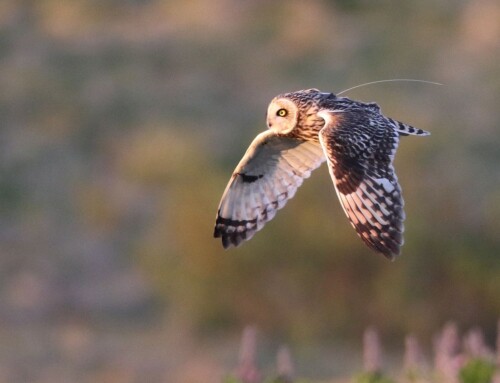LINKED PAPER
Birds and human health: Pathways for a positive relationship and improved integration. Gray, A., Doyle, S., Doyle, C., Young, J.C., McMahon, B.J. 2023. IBIS. DOI:10.1111/ibi.13290 VIEW
In this era marked by unprecedented biodiversity loss and environmental challenges, the integrated relationships of biodiversity, ecosystems and human health are gaining attention; and the impacts of this biodiversity loss on human health are being realised. We all know just how immense the need for conservation is. However, the effectiveness of any conservation strategy relies on how much value, both objective and subjective, we place on biodiversity in the first place. This is important because leveraging conservation does not always translate to value for humans. To accomplish our collective conservation goals, we need more tangible – perhaps more anthropocentric – leverage points. As we continue to lose biodiversity, concern is rising for human wellbeing and quality of life (e.g. Cardinale et al. 2012). Emphasising the link between biodiversity and human health could help shift the narrative and highlight the value of conservation to us.
Why look to birds?
With growing research into the ‘One Health’ concept – that is, the interdisciplinary approach that appreciates that the health of humans, domestic and wild animals, plants, and the environment are interdependent (Adisasmito et al. 2022) – comes mounting evidence that our health is intricately linked to the health of ecosystems around us. The interconnectedness of wild birds and human health fits in perfectly with this approach.
Nature’s custodians
Birds play a pivotal role in ecosystem balance through pollination and pest control. For instance, hummingbirds are adept pollinators. While feeding on nectar they transfer pollen from flower to flower, facilitating plants’ reproduction. Birds also contribute to pest control services which support agricultural production – in some cases removing the need for pesticides that are potentially harmful for human health (Pejchar et al. 2018). Insectivorous species like flycatchers are natural pest controllers by preying on insects, helping regulate populations, preventing pest outbreaks that could negatively impact crops. Not to mention raptors keeping rodent numbers in check can be as effective as the use of rodenticides, with the added bonus of reduced cost to the farmer. In this way you could say that while keeping our ecosystems clean and functioning, birds are like nature’s custodians.
Food, medicine and culture
From the nutritional benefits gotten from wild bird meat to the income provided by bird-related ecotourism, wild birds have a tangible effect on human life globally. Many cultures use birds such as vultures in sorcery and spiritual custom and consume them because of their cultural significance (e.g. Henriques et al. 2018). Wild birds are also used in traditional medicine; and in the lab, cells from Turkey Vultures have even been found to kill human cervical cancer cells (Del Rosario Jacob-Salcedo et al. 2013)!
However, it’s important to highlight that the use of wild birds for medicinal purposes raises concerns for ethics and exploitation. It may even pose a threat to conservation efforts if left unregulated. Education and the promotion of sustainable, evidence-based healthcare are always needed.
Not just the physical
Beyond our physical health, being in the presence of wild birds can have profound effects on mental wellbeing. Many of us use bird-related recreation for mood lifting and relaxation, with birdwatching being linked to reduced stress, anxiety, and depression (Cox et al. 2017). Birds can even facilitate human connection to nature which is often recommended for human health and wellbeing (e.g. Clark et al. 2019).
Considering public health
Whilst birds have been identified as potential reservoirs for zoonotic diseases (illnesses that can be transmitted between animals and humans), emphasis should be placed on the importance of birds in public health. Wild birds can serve as sentinels, indicating the presence of zoonotic diseases in the environment. Monitoring bird populations such as waterfowl for avian influenza or corvids for West Nile virus, helps authorities predict and respond to potential human outbreaks. Understanding the dynamics of zoonoses in bird populations is critical to prevent future pandemics.
For the future
As we champion biodiversity conservation efforts, we as humans could easily overlook the connections between wild birds and our own wellbeing. However, by embracing the One Health concept, recognising and understanding these links, we could support conservation while also ensuring the future health and wellbeing of humans and the wildlife with whom we share the planet.
References
Adisasmito, W.B., Almuhairi, S., Behravesh, C.B., Bilivogui, P., Bukachi, S.A., Casas, N., Becerra, N.C., Charron, D.F., Chaudhary, A., Zanella, J.R.C. & Cunningham, A.A. 2022. One Health: A new definition for a sustainable and healthy future. PLoS Pathogens 18:6. VIEW
Cardinale, B.J., Duffy, J.E., Gonzalez, A., Hooper, D.U., Perrings, C., Venail, P., Narwani, A., Mace, G.M., Tilman, D., Wardle, D.A. & Kinzig, A.P. 2012. Biodiversity loss and its impact on humanity. Nature 486:59. VIEW
Clark, D.N., Jones, D.N. & Reynolds, S.J. 2019. Exploring the motivations for garden bird feeding in south-east England. Ecology and Society 24:1. VIEW
Cox, D.T., Shanahan, D.F., Hudson, H.L., Plummer, K.E., Siriwardena, G.M., Fuller, R.A., Anderson, K., Hancock, S. & Gaston, K.J. 2017. Doses of neighborhood nature: the benefits for mental health of living with nature. BioScience 67. VIEW
del Rosario Jacobo-Salcedo, M., del Carmen Juarez-Vazquez, M., González-Espíndola, L.Á., Maciel-Torres, S.P., García-Carrancá, A. & Alonso-Castro, A.J. 2013. Biological effects of aqueous extract from Turkey vulture Cathartes aura (Cathartidae) meat. Journal of Ethnopharmacol. 145. VIEW
Henriques, M., Pedro Granadeiro, J., Monteiro, H., Nuno, A., Lecoq, M., Cardoso, P., Regalla, A. & Catry, P. 2018. Not in wilderness: African vulture strongholds remain in areas with high human density. PLoS One 13. VIEW
Pejchar, L., Clough, Y., Ekroos, J., Nicholas, K.A., Olsson, O.L.A., Ram, D., Tschumi, M. & Smith, H.G. 2018. Net effects of birds in agroecosystems. BioScience 68. VIEW
Image credits
Top right: White-rumped Vulture © S Lovell.
Blog posts express the views of the individual author(s) and not those of the BOU.
If you want to write about your research in #theBOUblog, then please see here.



